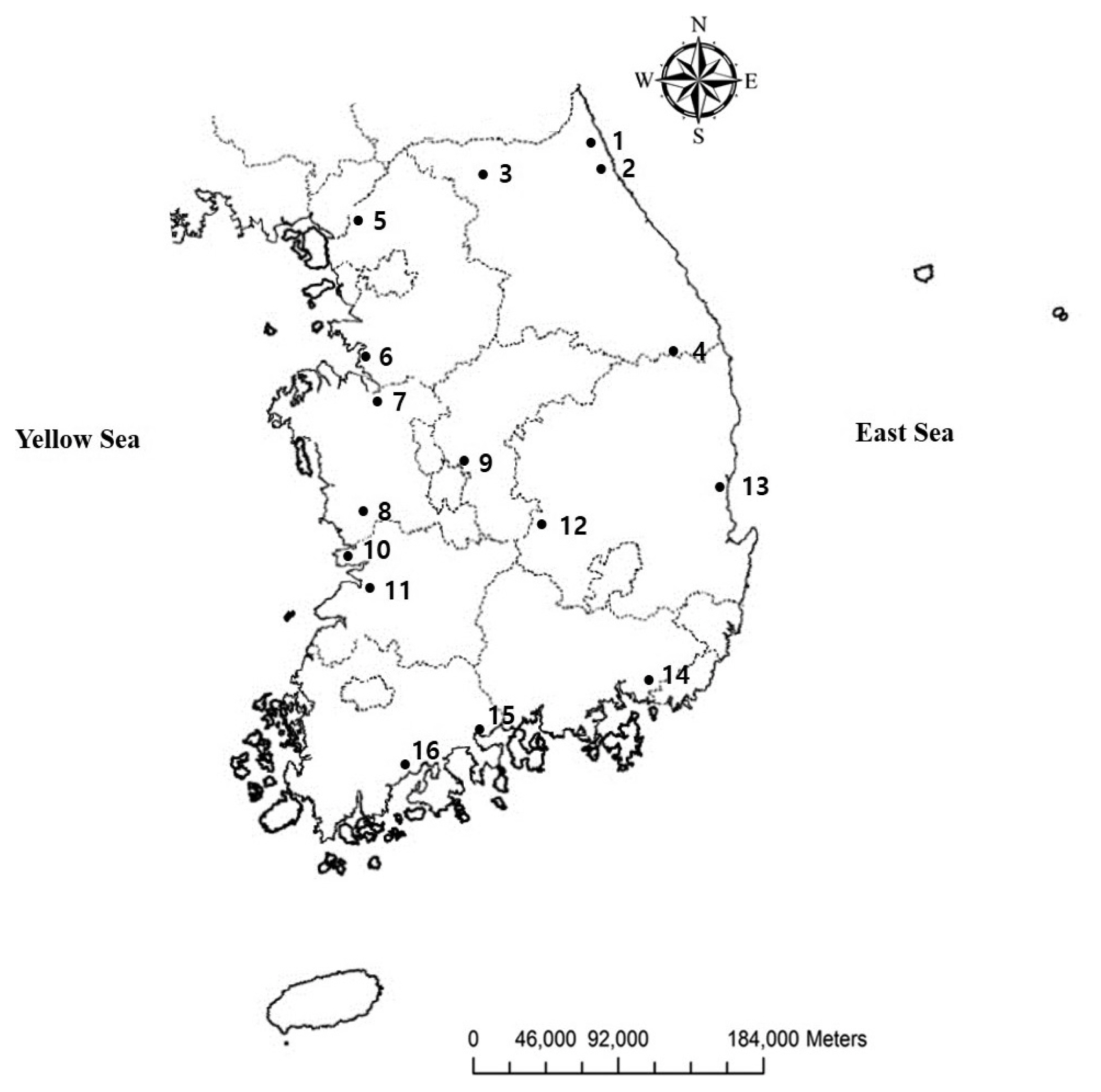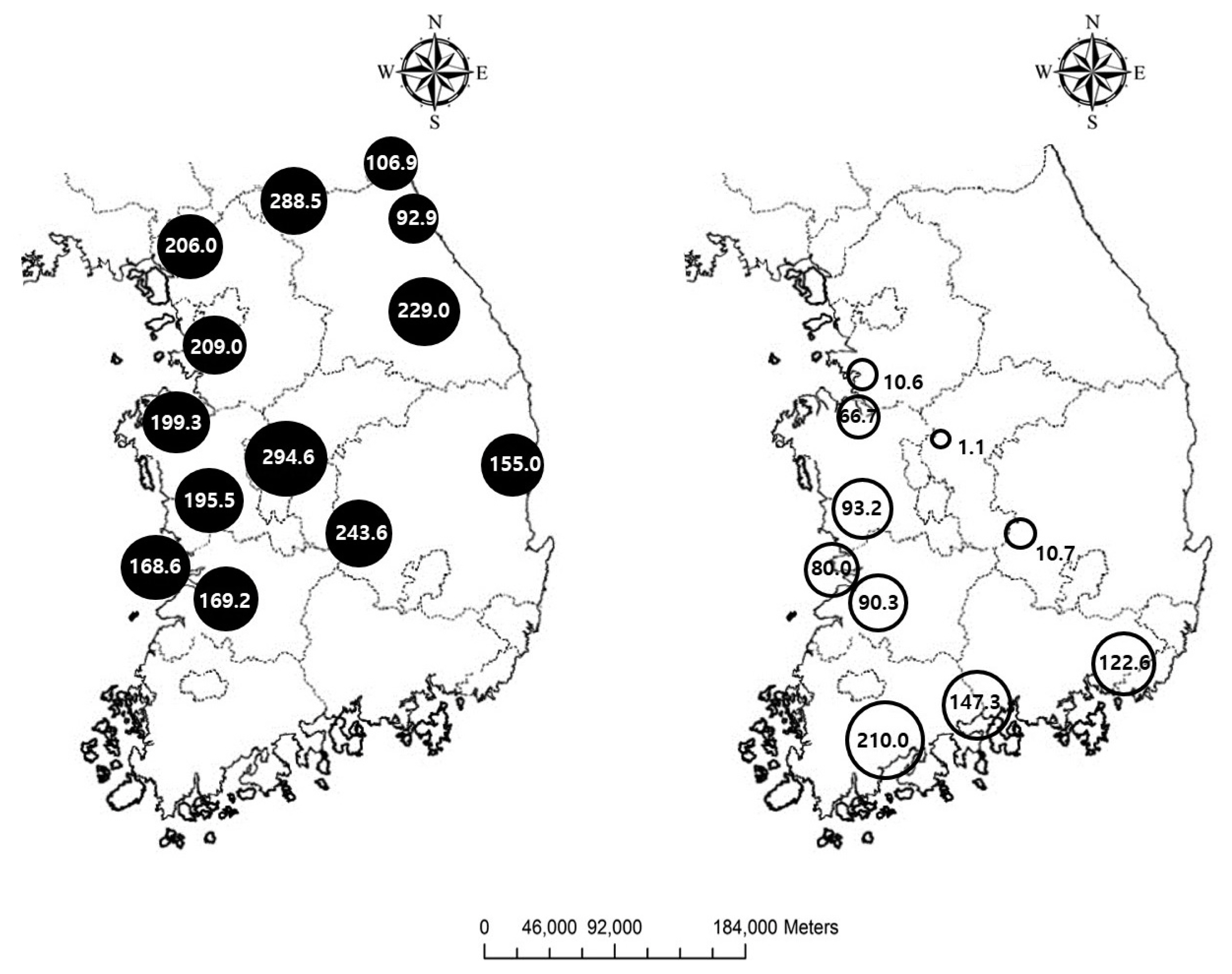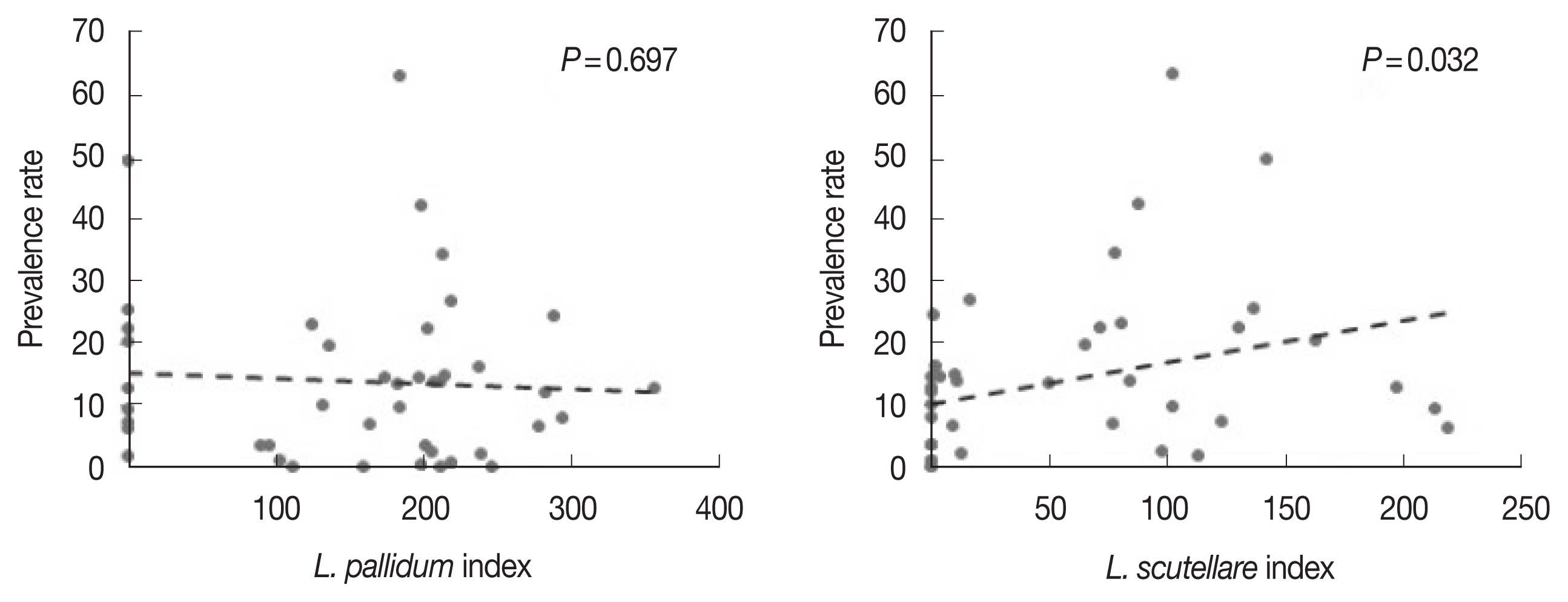AbstractA nationwide survey of chigger mites causing scrub typhus and an investigation of epidemiologic factors for chigger mites was conducted at 16 localities in 8 provinces in Korea during autumn 2009, 2012, and 2013. A total of 233 Apodemus agrarius were captured, and all were infested with chigger mites. The chigger index was highest in Chungcheongbuk-do in 2009 (358.3) and 2012 (290.1) and Chungcheongnam-do in 2013 (294.4). The predominant chigger mite species was Leptotrombidium pallidum in the northern and central parts and L. scutellare in the southern and western parts, Korea. L. pallidum was not found in Jellanam-do and Gyeongsangnam-do and the distribution of L. scutellare had been expanded in the northern parts of Korea. The chigger index of L. pallidum was positively correlated with temperature and negatively correlated with humidity. The incidence of scrub typhus is dependent on L. scutellare index. These findings could be helpful to monitor the distribution of chigger mites and to develop a preventive measures for scrub typhus in Korea.
INTRODUCTIONScrub typhus, a major febrile disease, is prevalent in Asian countries, including China, Japan, and Korea [1,2]. Orientia tsutsugamushi, the causative agent of scrub typhus, is transmitted to humans through the bite of infected trombiculid mites [3, 4]. Apodemus agrarius is a dominant wild rodent that harbors infected chigger mites [5]. Forty-four species of chigger mites, including L. pallidum, L. scutellare, L. palpale, L. orientale, and L. zetum, have been reported as vectors of scrub typhus in Korea [6]. The chigger indices and seropositive rates of scrub typhus in wild rodents were highest in autumn. Because trombiculid mites lay eggs in the summer in Korea, the incidence of scrub typhus in humans peaks in the autumn months [3,7–9]. The annual number of scrub typhus cases had increased to 10,365 in 2013.
Several epidemiological data on the abundance of chigger mites, their hosts, and geographic distribution have been published; however, most have focused on limited areas. In this study, we investigated the nationwide geographical distribution of chigger mites (Leptotrombidium species) in striped field mice (A. agrarius) in Korea during the scrub typhus outbreak season (October and November). In addition, we analyzed the relationship between chigger mites and weather conditions and the incidence of scrub typhus.
MATERIALS AND METHODSCollection sitesA total of 16 study areas in 8 provinces (Gangwon-do, Gyeonggi-do, Chungcheongbuk-do, Chungcheongnam-do, Gyeongsangbuk-do, Gyeonsangnam-do, Jeollabuk-do, Jeollanam-do) were surveyed during October and November of 2009, 2012, and 2013 (Fig. 1). Five study areas (Goseong, Sokcho, Hwacheon, Taebaek, and Buyeo) were not included in 2009.
Collection of field rodents and chigger mites
A. agrarius was captured using Sherman live traps (3×3×9 in) baited with an oat-peanut butter mixture. The traps were set up at the collection points 2–3 m apart in late afternoon and the rodents trapped were collected early next morning. The live-captured adult rodents were euthanized in the laboratory. The rodents were hung individually over a 1,000 ml beaker filled with tap water to a depth of 1 cm to harvest the larval mites. The mites escaped into water were collected using a fine brush, placed in 75% ethanol, and were mounted on slides with Hoyer’s medium. The larval mites were identified under a stereomicroscope using morphological keys [10].
Epidemiologic investigations and statisticsThe average temperature, relative humidity, and precipitation in the collection localities were based on data from the Korea Meteorological Administration (http://www.kma.go.kr). The prevalence rates (No. cases/100,000 population) of scrub typhus at collection localities were obtained from the National Notifiable Disease Web Statistics System (http://www.cdc.go.kr). Statistical analyses were performed using SAS (version 9.2; SAS Incorporation, Cary, North Carolina, USA), and statistical significance was set at P<0.05.
RESULTSA total of 233 A. agrarius were captured at 16 study sites for 3 years. The yearly trapping rates were 12.2%, 12.5%, and 12.0% in 2009, 2012, and 2013, respectively. All adult A. agrarius were infested with chigger mites (Table 1). The yearly average chigger indices of Leptotrombidium species from A. agrarius are shown in Table 2. The chigger index was highest in Chungcheongbuk-do (358.3) followed by Jeollabuk-do (305.4) in 2009, Chungcheongbuk-do (290.1) followed by Chungcheongnam-do (286.2) in 2012, and Chungcheongnam-do (294.4) followed by Chungcheongbuk-do (240.0) in 2013. There was no significant difference in the chigger indices among the years. The predominant chigger mites were L. pallidum and L. scutellare. The average chigger index of L. pallidum at each site ranged from 0 to 294.6, and that of L. scutellare ranged from 0 to 210.0. L. pallidum was predominant at 13 collection sites (Goseong, Sokcho, Hwacheon, Taebaek, Paju, Hwaseong, Asan, Buyeo, Cheongju, Gunsan, Gimje, Gimcheon, and Yeongdeok), and L. scutellare at 3 collection sites (Gimhae, Gwangyang, and Boseong) (Fig. 2). L. palpale, L. orientale, and L. zetum showed uneven geographical distributions and very low chigger indices (0–12.5). The chigger index of L. pallidum was negatively correlated with temperature (P=0.036) and positively correlated with relative humidity (P=0.022). Meanwhile, the chigger index of L. scutellare was positively correlated with temperature but not significant (P=0.200). The chigger index was not affected by precipitation (Fig. 3). Moreover, the chigger index of L. scutellare was positively correlated with the prevalence rate of scrub typhus (Fig. 4).
DISCUSSIONIn this study, all adult A. agrarius were infested with chigger mites. It is known that the chigger infestation rate was variable. It was dependent on the seasons, and was highest during autumn and lowest during summer in Korea [3,11,12]. L. scutellare was not found in 5 collection sites (Goseong, Sokcho, Hwacheon, Taebaek, and Paju) located in the northern and eastern parts of Korea, whereas L. pallidum was not found in 3 collection sites (Gimhae, Gwangyang, and Boseong) located in the southern parts of Korea (Fig. 2). The geographical distribution of L. scutellare varied by collection sites. It was found in the southern and western areas, but not in the northern areas, Korea [3,8]. It is reported that L. scutellare is found in areas where the annual average air temperature is >10°C [13]. A previous study in October and November 2006 showed that A. agrarius in Chungcheongbuk-do, Chungcheongnam-do, Gyeonggi-do, and Gangwon-do was not infested with L. scutellare [8], while in this study, L. scutellare was found in Chungcheongbuk-do, Chungcheongnam-do, and southern area of Gyeonggi-do (Hwaseong). Chigger index of L. scutellare decreased in the northern and eastern areas of Korea. Recent reports have shown that L. scutellare was also found in Hwaseong in October and November 2015, and the ratio of L. scutellare to L. pallidum was increased to 0.58 [14]. In this study, the average ratio of L. scutellare to L. pallidum in Hwaseong for 3 years (2009, 2012, and 2013) was 0.05. L. pallidum was found in southern provinces, such as Jeollanam-do and Gyeongsangnam-do but not Jeju-do in 2005, 2006, and 2007 [3,8,15]. In this study, L. pallidum was not found in Jeollanam-do and Gyeongsangnam-do in 2009, 2012, and 2013. Taken together, these data strongly suggest geographical distribution of L. pallidum and L. scutellare was changed. The chigger index increased after hot and humid summers [16] and moist soil was suitable for chigger survival [9]. A possible explanation is that global warming might affect the distribution and trigger indices of L. pallidum and L. scutellare. In this study, precipitation had no relationship with the chigger indices of L. pallidum and L. scutellare. Precipitation is known to influence mite development, reproduction, and population dynamics [17]. Because we performed this survey during the autumn season, it is possible that there was no correlation between precipitation and the chigger index.
The chigger index of L. scutellare, but not L. pallidum, was correlated to the incidence of scrub typhus in this study areas. This is in agreement with a previous study demonstrating that the geographical distribution of the chigger index of L. scutellare was identical to the incidence of scrub typhus [15], and the relative population density of chigger mites was associated with an annual increase of scrub typhus cases in autumn [8,11]. This coincidental geographical distribution of L. scutellare and scrub typhus cases was also reported in Japan [18]. In Korea, the infection rate of O. tsutsugamushi was high in L. palpale (5.3%), followed by L. scutellare (3.7%), L. orientale (3.6%), and L. pallidum (1.5%) [19]. Although the predominant species of chigger mites in Korea were L. pallidum and L. scutellare, the infection rate of O. tsutsugamushi in L. scutellare was much higher than that in L. pallidum. The distribution and high population of L. scutellare had been expanded in the northern parts of Korea. In addition, the occurrence of scrub typhus gradually extends northward [12]. These findings also support our data that the incidence of scrub typhus is positively correlated with L. scutellare.
This nationwide epidemiologic study of chigger mites in wild rodents will provide necessary baseline data for distribution of chigger mites and for controlling scrub typhus.
ACKNOWLEDGMENTThis study was supported by research grant from National Institute of Biological Resources (NIBR), Ministry of Environment, Korea.
REFERENCES1. Seong SY, Choi MS, Kim IS. Orientia tsutsugamushi infection: overview and immune responses. Microbes Infect 2001;3:11-21. https://doi.org/10.1016/s1286-4579(00)01352-6
2. Chang WH. Current status of tsutsugamushi disease in Korea. J Korean Med Sci 1995;10:227-238. https://doi.org/10.3346/jkms.1995.10.4.227
3. Lee SH, Lee YS, Lee IY, Lim JW, Shin HK, Yu JR, Sim S. Monthly occurrence of vectors and reservoir rodents of scrub typhus in an endemic area of Jeollanam-do, Korea. Korean J Parasitol 2012;50:327-331. https://doi.org/10.3347/kjp.2012.50.4.327
4. Bang HA, Lee MJ, Lee WC. Comparative research on epidemiological aspects of tsutsugamushi disease (scrub typhus) between Korea and Japan. Jpn J Infect Dis 2008;61:148-150.
5. Park SW, Ha NY, Ryu B, Bang JH, Song H, Kim Y, Kim G, Oh MD, Cho NH, Lee JK. Urbanization of scrub typhus disease in South Korea. PLoS Negl Trop Dis 2015;9:e0003814. https://doi.org/10.1371/journal.pntd.0003814
6. Kim HC, Lee IY, Chong ST, Richards AL, Gu SH, Song JW, Lee JS, Klein TA. Serosurveillance of scrub typhus in small mammals collected from military training sites near the DMZ, northern Gyeonggi-do, Korea, and analysis of the relative abundance of chiggers from mammals examined. Korean J Parasitol 2010;48:237-243. https://doi.org/10.3347/kjp.2010.48.3.237
7. Park JW, Yu DS, Lee GS, Seo JJ, Chung JK, Lee JI. Epidemiological characteristics of rodents and chiggers with Orientia Tsutsugamushi in the Republic of Korea. Korean J Parasitol 2020;58:559-564. https://doi.org/10.3347/kjp.2020.58.5.559
8. Lee IY, Kim HC, Lee YS, Seo JH, Lim JW, Yong TS, Klein TA, Lee WJ. Geographical distribution and relative abundance of vectors of scrub typhus in the Republic of Korea. Korean J Parasitol 2009;47:381-386. https://doi.org/10.3347/kjp.2009.47.4.381
9. Elliott I, Pearson I, Dahal P, Thomas NV, Roberts T, Newton PN. Scrub typhus ecology: a systematic review of Orientia in vectors and hosts. Parasit Vectors 2019;12:513. https://doi.org/10.1186/s13071-019-3751-x
10. Ree HI. Fauna and key to the chigger mites of Korea (Acarina: Trombiculidae and Leeuwenhoekiidae). Korean J Syst Zool 1990;6:57-70.
11. Park JW, Kim SH, Park DW, Jung SH, Park HJ, Seo MH, Song HJ, Lee JY, Kim DM, Kim CM, Gill BC, Jeong HJ, Lee JM, Ha DR, Kim ES, Chung JK. Molecular epidemiology of an Orientia tsutsugamushi gene encoding a 56-kDa type-specific antigen in chiggers, small mammals, and patients from the southwest region of Korea. Am J Trop Med Hyg 2018;98:616-624. https://doi.org/10.4269/ajtmh.17-0070
12. Park GM, Shin HS. Geographical distribution and seasonal indices of chigger mites on small mammals collected on the east coast of the Republic of Korea. J Parasitol 2016;102:193-198. https://doi.org/10.1645/15-760
13. Ree HI, Lee IY, Jeon SH, Yoshida Y. Geographical distribution of vectors and sero-strains of tsutsugamushi disease at mid-south inland of Korea. Korean J Parasitol 1997;35:171-179. https://doi.org/10.3347/kjp.1997.35.3.171
14. Bahk YY, Jun H, Park SH, Jung H, Jegal S, Kim JMD, Roh JY, Lee WG, Ahn SK, Lee J, Joo K, Gong YW, Kwon MJ, Kim TS. Surveillance of chigger mite vectors for tsutsugamushi disease in the Hwaseong area, Gyeonggi-do, Republic of Korea, 2015. Korean J Parasitol 2020;58:301-308. https://doi.org/10.3347/kjp.2020.58.3.301
15. Roh JY, Song BG, Park WI, Shin EH, Park C, Park MY, Chang KS, Lee WG, Lee HI, Shin EH. Coincidence between geographical distribution of Leptotrombidium scutellare and scrub typhus incidence in South Korea. PLoS One 2014;9:e113193. https://doi.org/10.1371/journal.pone.0113193
16. Kim SH, Jang JY. Correlations between climate change-related infectious diseases and meteorological factors in Korea. J Prev Med Public Health 2010;43:436-444. https://doi.org/10.3961/jpmph.2010.43.5.436
17. Gage KL, Burkot TR, Eisen RJ, Hayes EB. Climate and vectorborne diseases. Am J Prev Med 2008;35:436-450. https://doi.org/10.1016/j.amepre.2008.08.030
18. Ogawa M, Ono T. Epidemiological characteristics of tsutsugamushi disease in Oita refecture, Japan: yearly and monthly occurrences of its infections and serotypes of its causative agent, Orientia tsutsugamushi, during 1984–2005. Microbiol Immunol 2008;52:135-143. https://doi.org/10.1111/j.1348-0421.2008.00024.x
19. Lee HI, Shim SK, Song BG, Choi EN, Hwang KJ, Park MY, Park C, Shin EH. Detection of Orientia tsutsugamushi, the causative agent of scrub typhus, in a novel mite species, Eushoengastia koreaensis, in Korea. Vector Borne Zoonotic Dis 2011;11:209-214. https://doi.org/10.1089/vbz.2009.0180
Fig. 1Map of the collection sites. ① Goseong, Gangwon-do (N38° 17′ 01.2″, E128° 31′ 24.4″); ② Sokcho, Gangwon-do (N38° 12′ 06.1″, E128° 31′ 00.6″); ③ Hwacheon, Gangwon-do (N38° 01′ 43.4″, E127° 49′ 42.4″); ④ Taebaek, Gangwon-do (N37° 06′ 38.1″, E129° 00′ 23.5″); ⑤ Paju, Gyeonggi-do (N37° 48′ 52.4″, E126° 42′ 36.0″); ⑥ Hwaseong, Gyeonggi-do (N37° 01′ 33.2″, E126° 51′ 25.2″); ⑦ Asan, Chungcheongnam-do (N36° 46′ 35.0″, E126° 51′ 24.2″); ⑧ Buyeo, Chungcheongnam-do (N36° 16′ 51.2″, E126° 46′ 35.5″); ⑨ Cheongju, Chungcheongbuk-do (N36° 29′ 17.6″, E127° 25′ 21.9″); ⑩ Gunsan, Jeollabuk-do (N36° 03′ 00.5″ E126° 49′ 47.3″); ⑪ Gimje, Jeollabuk-do (N35° 49′ 06.1″, E126° 51′ 41.2″); ⑫ Gimcheon, Gyeongsangbuk-do (N36° 06′ 33.1″, E128° 00′ 53.6″); ⑬ Yeongdeok, Gyeongsangbuk-do (N36° 22′ 01.0″, E129° 22′ 49.6″); ⑭ Gimhae, Gyeongsangnam-do (N35° 12′ 27.1″, E128° 52′ 58.1″); ⑮ Gwangyang, Jeollanam-do (N34° 59′ 02.6″, E127° 43′ 19.0″); ⑯ Boseong, Jeollanam-do (N34° 49′ 56.2″, E127° 18′ 38.0″). 
Fig. 2Average chigger indices of Leptotrombidium pallidum (●) and L. scutellare (○) collected from Apodemus agrarius at the collection sites. 
Fig. 3The relationship between chigger indices and weather conditions at the collection sites. (A) temperature, (B) relative humidity, (C) precipitation. 
Fig. 4The relationship between chigger indices and prevalence rates of scrub typhus at the collection sites. 
Table 1Yearly trapping rates and chigger infestation rates of A. agrarius in Korea from October to November in 2009, 2012, and 2013
Table 2Yearly chigger indices for Leptotrombidium species collected from Apodemus agrarius in each province, Korea |
|
||||||||||||||||||||||||||||||||||||||||||||||||||||||||